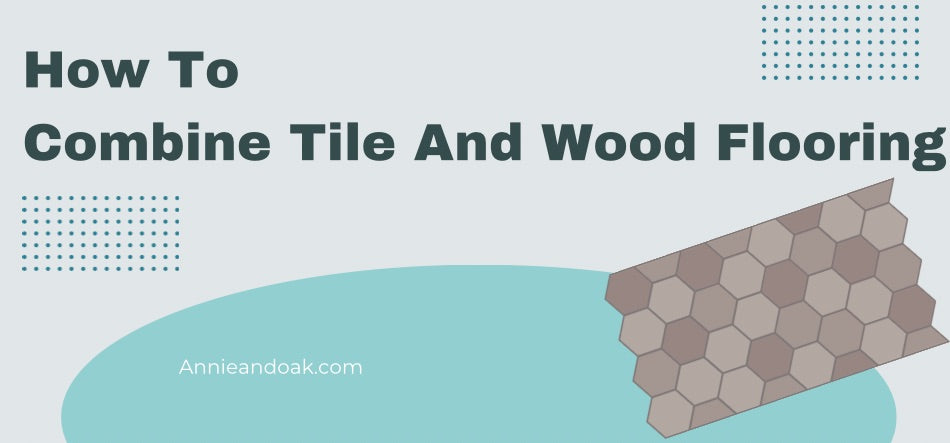
How To Combine Tile And Wood Flooring

Do you just love the look of a natural wooden floor but you also prefer to have the ease-of-use with stone tiles?
Of course you can choose one or the other matching with your home’s interior but what if you did not have to decide for one or the other?
Combining stone tiles with wood flooring is not as difficult as it may sound. This so called “mixed media” flooring is becoming ever more popular amongst home owners.
The combination of tiles, stone and wood in your floor creates a truly unique design that adds a personal touch to your home.
But what type of flooring should you choose? And is stone better than ceramic?
We take a look at what you need to consider when combining wood and tiles to create a stunning floor design.
Choose The Right Materials
When it comes to combing different types of materials, it is all about understanding how each of these materials works individually.
This is not just important for the perfect finish but it is essential during the installation. Combining the wrong materials can lead to a lot of problems further down the line.
As an example, water and any kind of wood do not mix very well. Water can cause wood to swell up and crack.
But if you want to install stone tiles next to wood, then you will need water to secure these tiles in place (as part of grout, for example).
Make sure that both your wood and the stone tiles are hard-wearing and at least waterproof.
It’s important to remember that hardwood floors may look beautiful but they can easily get scratched, dented, cracked and chipped n busy areas, such as the living room and kitchen.
This does not just mean you will need to be extra careful with this type of flooring material, but hardwood also requires more maintenance.
It needs to be regularly refinished and resealed to ensure that it does not get damaged even more.
As an alternative, you may want to consider faux wood tiles which are much more resilient and durable, especially for households with pets and children.
Take a look at the section about alternatives below.
Careful Planning And Installation

The installation of a mixed media floor does require some careful planning to avoid any issues during the installation, and with the end result.
Your floor installer should set the tiles first, as they need to dry. Then you can apply the wood.
This may sound straightforward but it does need attention to detail because you need to set the tiles accurately to ensure that the hardwood sits flush with all edges.
In addition, you need to consider the different heights of hardwood, stone and tiles. All these heights need to be matched and adjusted accordingly to make sure that your floor is even.
This means that your installer must measure very carefully and plan ahead with your chosen materials and pattern in mind.
Choose Your Pattern
Choosing your flooring pattern goes almost hand in hand with finding the right materials.
There is a large variety of possible patterns for mixed media floors.
One of the most popular designs is to include a stone medallion with a wooden border as a ready-made piece.
The advantage of this pattern is that they come often pre-assembled which means they are much easier to install, and you do not have to worry about finding matching materials.
Depending on your chosen manufacturer, the ready-made medallions can be cut to the size and pattern you want. Some may be shipped as full slabs, while others may come in sections.
These pre-fabricated tiles typically have a standard thickness of ⅜ inches, which matches standard engineered floors.
However, each floor is different so it is best to check with your installer before buying to ensure that the tiles match.
Alternatively, you can use a simple clean line design which creates a neat trim between the wood planks and the tiles. This is the traditional pattern which requires a lot more planning.
A lot of this will depend on your preferred materials and any local workmen you have available. They will be able to cut the stone tiles and wood to the exact size.
The advantage of using individual materials is that you can create much more intricate designs, and you can be more flexible with different floor shapes.
As long as you plan in advance and discuss your intended pattern and materials with your installer, you can create almost any flooring design you can imagine.
Consider Alternatives
If it is all about bringing a more natural look into your home, then it’s also a good idea to explore some alternatives.
One good option to consider is a combination of different tiles which look similar to wood. As these types of tiles are all made of ceramic or porcelain, they are a lot less difficult to install.
These tiles are called faux wood tiles, and you may not even have ever noticed walking on one of these tiles as they look so very realistic.
The biggest advantage with faux wood tile floors is that they give you exactly the same look as you get with wooden floors but they are much more durable.
Faux-wood comes in a variety of colors, patterns and different wood grains, so there are plenty of options to mix and match.
This is also a great advantage when you want to combine different looks.
You can choose standard stone tiles and match them with faux-wood choosing from different colors, sizes and grains.
This can help create a very individual style and pattern that is unique to your home and your taste.
Conclusion
Replacing your floor is an expensive investment, and you need to make sure that you choose the right materials, pattern and workmanship to get an excellent result.
Saying this, with some careful planning, it isn’t too difficult to combine tiles and wood to create a stunning, customized floor for your home.






